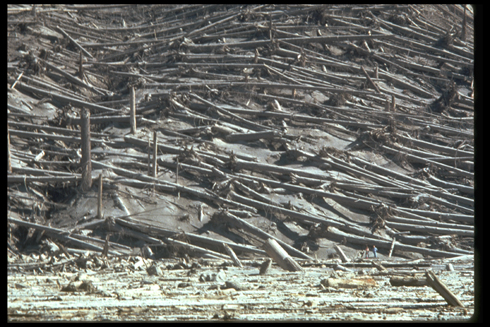Clearcutting
The Effects of Destructive Logging
Two of the major effects of destructive clearcut logging are blowdown and landslides.
Blowdown

Some trees, usually in small patches, are often left standing when an area is clearcut logged. In many cases, however, because these trees are now very exposed they are knocked down by wind. This is called blowdown.
Fierce winter winds on the British Columbia coast make trees in logged areas especially susceptible to blowdown, and coastal residents tell of seeing trees in small patches fall one after another like dominoes.
Until trees in a second-growth forest reach the same height as the surrounding forest that was not logged, they will remain susceptible to blowdown. In ancient rainforests, like those of our study area, it can take more than a century for trees to reach this height.
While blowdown occurs in all of the rainforests on British Columbia’s coast, the forests of Haida Gwaii (Queen Charlotte Islands) are particularly vulnerable. The extreme westerly position of Haida Gwaii means it takes the brunt of most winter storms. Much of the soil on these islands, which are often called ‘Canada’s Galapagos’, is both thin and saturated with water, increasing the probability of blowdown. Forests are susceptible to blowdown for decades after logging occurs, but on Haida Gwaii our research found that 15 percent of trees retained in logging sites had blown down within one year of logging.
Blowdown affects both the trees that surround a clearcut, as well as the remaining patches of trees within it. Research for this report found that much of the tree retention within logging sites was intended to protect ecological values such as bear dens and salmon streams, or the cultural values of local First Nations. When the trees retained for these purposes blow down, these values are also lost.
However, blowdown can provide an economic bonus for timber companies as they are allowed to remove and sell any trees that the wind has blown down.
Landslides

Landslides are the result of poor logging practices, particularly clearcut logging, and activities like road building, which can be extremely destructive. When a forest is clearcut logged, trees and plants are removed that absorb large quantities of water. The intricate root systems of some of these plants, which help hold soil in place, are also destroyed. After clearcutting, heavy rains can wash away much of the remaining soil, leaving behind bare rock. It can take 800 years in these rainforests for one inch of soil to be restored. Therefore, it would be thousands of years before the soil would attain the pre-logging level of fertility throughout the forest.
Road building can also destabilise soil, leading to landslides. When roads are built on hillsides the uphill side of the slope is artificially steepened, which leaves the soil vulnerable to sliding. Road building also alters the drainage of groundwater, which can result in a concentration water in certain locations. Then, when soils become saturated, they more easily flow down slopes, causing landslides.
We are aware of three logging sites in our study area that developed landslides within a year of being logged. These occurred in the Mid Coast Forest District at Tom Bay (near Bella Bella) and were logged by Western Forest Products Ltd. In these cases, heavy winter rains saturated the soil, causing landslides that tore trees right off the slopes.
These logging sites are located on remote parts of the British Columbia coast only accessible by air or water. Because of that, we have been unable to revisit very many of them since our field surveys in August 2002. We believe, however, that because of current logging practices it is likely many more landslides have occurred throughout the study area since then.


